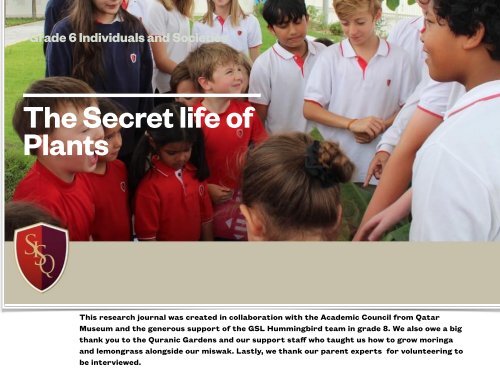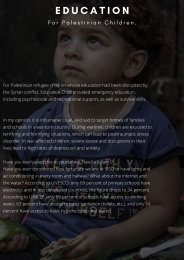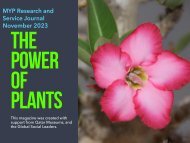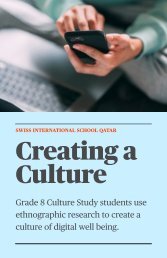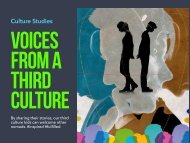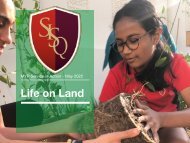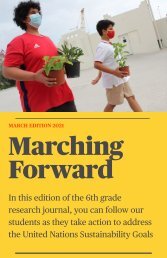The Secret life of Plants
In collaboration with Qatar National Museum, Grade 6 students at Swiss International School Qatar have produced a magazine to preserve oral medical traditions and cultural practices. They also create ethical cosmetics and explore how football stadiums could feed hungry people. We are only young scientists so we do welcome feedback. This is a magazine written by children for children so there will be mistakes. Errata: Zaid's name is misspelled. The author is named Zade.
In collaboration with Qatar National Museum, Grade 6 students at Swiss International School Qatar have produced a magazine to preserve oral medical traditions and cultural practices. They also create ethical cosmetics and explore how football stadiums could feed hungry people. We are only young scientists so we do welcome feedback. This is a magazine written by children for children so there will be mistakes. Errata: Zaid's name is misspelled. The author is named Zade.
Create successful ePaper yourself
Turn your PDF publications into a flip-book with our unique Google optimized e-Paper software.
Grade 6 Individuals and Societies<br />
<strong>The</strong> <strong>Secret</strong> <strong>life</strong> <strong>of</strong><br />
<strong>Plants</strong><br />
This research journal was created in collaboration with the Academic Council from Qatar<br />
Museum and the generous support <strong>of</strong> the GSL Hummingbird team in grade 8. We also owe a big<br />
thank you to the Quranic Gardens and our support staff who taught us how to grow moringa<br />
and lemongrass alongside our miswak. Lastly, we thank our parent experts for volunteering to<br />
be interviewed.
Shh! We’re in a library and the<br />
books are 900 years old!<br />
You might not realize this but not<br />
everything can be found on google.<br />
Some knowledge is so ancient that we<br />
can only find it in the heads <strong>of</strong> ancient<br />
people -that’s why we need museums!<br />
When grade 6 first started learning about Qatar’s green<br />
heritage, we really struggled to find anything. That’s<br />
because the older generation transmitted their<br />
knowledge orally and the younger generation never<br />
wrote it down.<br />
This meant that all this valuable knowledge could<br />
be lost but luckily Qatar National Museum was here<br />
to save the day!<br />
<strong>The</strong>y not only allowed teachers like me into their<br />
archives, but they also helped me with translations and<br />
checked my lessons so my grade 6s could celebrate<br />
Qatar’s green heritage - and record the green<br />
heritage <strong>of</strong> their own cultures. Cultures like<br />
Palestine, Syria, India, France and Sudan.
Bedouin Beauty<br />
Making soap and body scrubs<br />
Many <strong>of</strong> our students were horrified<br />
to discover how many chemicals we<br />
used in modern skin care. Once again,<br />
the museum stepped in to show us<br />
how to make soaps and scrubs with<br />
natural products that our ancestors<br />
would use.<br />
Sidra is one <strong>of</strong> the most loved trees<br />
in our garden. Like the prophet<br />
Muhammad (Pbuph) we made<br />
shampoo and body wash with dried<br />
leaves and hot water. Nothing else.<br />
No pollution or chemicals. No animal<br />
testing. 100% halal.
Note before reading<br />
It takes a village to raise a child and<br />
children to build a garden. For those<br />
who don’t know much about Islam, it is<br />
believed that heaven is, in fact, a<br />
garden. Our grade 6s agree! <strong>The</strong>ir<br />
class work was not just about learning<br />
but a chance for all cultures to practice<br />
sadaqa or good deeds during Ramadan<br />
as we prepared the garden for summer<br />
and planted fruit trees. For children too<br />
young to fast, this was very important.<br />
As many students chose to research<br />
about plants that we were growing<br />
ourselves, I have highlighted these plants<br />
in their articles by putting them in bold<br />
font. When you see the bold font, you will<br />
know that we are cultivating these plants<br />
as part <strong>of</strong> our SISQ living classroom.<br />
Est, vel elit, congue wisi enim nunc
ADHD: Digging and planting a treatment -<br />
Salsabeel<br />
Imagine being a kid who can't sit still and can't focus well. Imagine sitting in<br />
a green environment that is lush and comfortable and is to your liking. In<br />
this magazine you will learn about ADHD (Attention Deficit<br />
Hyperactivity Disorder) and how plants can help calm people with ADHD<br />
in many ways. For thousands <strong>of</strong> years, people have been using plants to treat<br />
all different types <strong>of</strong> diseases. ADHD is a neurological disorder that can<br />
Affect the child's <strong>life</strong> and mind in many ways such as learning and socializing.<br />
I have a few family members that grew up with ADHD and their <strong>life</strong> was affected negatively by this<br />
disorder. <strong>The</strong>y had a lot <strong>of</strong> problems in school and had difficulties making and keeping friends. It was<br />
also very hard for their parents to deal with them because they were hyperactive and always getting<br />
into trouble.
Around 5.3 million children in the world have ADHD.<br />
Children with ADHD <strong>of</strong>ten struggle with school, are<br />
<strong>of</strong>ten injured more than normal kids and are socially<br />
isolated. <strong>The</strong> medications that doctors use to help<br />
these children have side effects. I strongly believe<br />
that plants can help children with ADHD through<br />
either the calming effects <strong>of</strong> planting or the<br />
medicinal benefits <strong>of</strong> herbs themselves.(Marketing<br />
Marketing)<br />
What is ADHD?<br />
ADHD is one <strong>of</strong> the most common neurological<br />
disorders in children. It affects up to 8.7% <strong>of</strong> children<br />
and <strong>of</strong>ten continues into adulthood. It is usually<br />
diagnosed in early childhood. Now, you may be asking<br />
“what does neurological mean” - well let me tell you<br />
that I didn't know either but now I do because my<br />
mom, who is a neurologist, explained to me that<br />
anything neurological has to do with the nervous<br />
system like the brain, spinal cord or nerves. (CDC)<br />
ADHD is serious. It has many symptoms and two <strong>of</strong> them are:<br />
Inattentiveness & Hyperactivity.<br />
<strong>The</strong>se can lead to many things; let's start with Inattentiveness:<br />
● Having limited focus and getting frequently distracted<br />
● Making careless mistakes, such as in homework<br />
● Being unable to stick with difficult or time-consuming tasks<br />
● Being unable to listen or follow instructions<br />
● Having difficulty arranging tasks<br />
Now let's move onto hyperactivity and impulsiveness:<br />
● being unable to sit still, particularly in peaceful or quiet settings<br />
● unable to focus on work because <strong>of</strong> common fidgeting<br />
● too much moving around,<br />
● too much chatting<br />
● not being able to wait their turn<br />
● behaving quickly<br />
● interrupting conversations<br />
● no or little awareness <strong>of</strong> danger
What calms people with ADHD?<br />
According to my research, the things that help children the<br />
most with ADHD are walking, running and activities like yoga or<br />
meditation. <strong>The</strong>se activities contain deep breathing and<br />
mindfulness and they are helpful to calm kids with ADHD. Even<br />
though there is no evidence that says that planting or gardening<br />
can help children with ADHD, I think that activities such as<br />
digging, planting, watering, and picking fruits and vegetables can<br />
help these kids burn out their excessive energy. (addrc)<br />
Do plants help with ADHD?<br />
<strong>Plants</strong> have been used for thousands <strong>of</strong> years for treating<br />
different illnesses. <strong>Plants</strong> can be used to manage ADHD in two<br />
main ways.<br />
Firstly, there are a number <strong>of</strong> herbs that have been shown that<br />
they can reduce symptoms <strong>of</strong> ADHD. For example: Ginkgo Biloba<br />
can help with improving memory and attention. A study was<br />
done in 2014 that showed that children who took Ginkgo Biloba<br />
for 3 - 5 weeks improved their symptoms. Other herbs that have<br />
also been used to treat ADHD include Brahmi (Bacopa monnieri)<br />
and Pine bark extract.(Story second way in which plants can<br />
help with ADHD is related to activities like planting and<br />
gardening. All kids love playing in the dirt and love the outside<br />
weather. A study done in the University <strong>of</strong> Illinois found that a<br />
A study was done in 2014 on Gingko Biloba as an ADHD<br />
treatment.<br />
green<br />
environment helps kids with ADHD to concentrate better and<br />
improve their attention. Another study also showed that<br />
houseplants can help children with ADHD to focus. Gardening<br />
and caring for plants can teach children with ADHD to be<br />
organized and responsible. In addition, planting and doing fun<br />
activities in the garden with other children can help make<br />
friends and get them to learn how to socialize.(Platt Hill<br />
Nursery) (“Dig In!”)<br />
Salsabeel’s big sister,<br />
Soundus, also deserves a<br />
shout out for setting the<br />
budget and helping to plant<br />
our original medical garden<br />
at SISQ. What a great legacy<br />
to leave her little sister.<br />
Salsabeel’s mom: Dr Ruba<br />
Benini
Can you calm kids with ADHD by<br />
using a naturalistic technique?<br />
In my personal experience, gardening<br />
(physically) helps me a lot with<br />
concentrating and calming<br />
down when I am frustrated or<br />
hyperactive. Children who are<br />
diagnosed with ADHD have lighter<br />
symptoms if they play in a green<br />
setting than if they play in built-up<br />
indoors or outdoor settings.<br />
(Armstrong)<br />
Overall, I think this topic was very fun and interesting<br />
to learn about. <strong>Plants</strong> can have a healing effect on<br />
children and especially on children with ADHD. This is<br />
why at SISQ the gardening team's goal is to have a<br />
very big garden where students and teachers can go<br />
and cool <strong>of</strong>f and reflect about their actions anytime.<br />
Every morning I come to school, my classmates and I<br />
go to the garden to check on the plants and make sure<br />
they are all healthy. Taking care <strong>of</strong> the garden gives<br />
students an opportunity to learn how to be<br />
responsible, how to pay attention and socialize.
Bibliography:<br />
https://www.cdc.gov/ncbddd/adhd/facts.html#:~:text=ADHD%20is%20one%20<strong>of</strong>%20the https://chadd.org/adhd-news/<br />
adhd-news-caregivers/green-time-for-adhd/#:~:text=Being%2<br />
0in%20nature%2C%20these%20researchers,not%20necessarily%20ADHD%2Drelated).<br />
https://www.addrc.org/how-to-create-a-calm-home-for-people-with-adhd/#:~:text=Restless<br />
ness%20and%20fidgety%20behavior%20associated,and%20induce%20relaxation%20an d%20calm<br />
<br />
https://platthillnursery.com/how-houseplants-can-help-you-study/#:~:text=Houseplants%2<br />
0Enhance%20Focus%20and%20Concentration&text=Researchers%20have%20been%20<br />
experimenting%20with,counterparts%20with%20no%20indoor%20plants<br />
https://www.institute4learning.com/2018/04/25/7-ways-to-use-nature-to-calm-and-focus-kid s-with-adhd/<br />
#:~:text=One%20study%20revealed%20that%20a,up%20indoors%20or%20 outdoor%20settings<br />
https://www.nhs.uk/conditions/attention-deficit-hyperactivity-disorder-adhd/symptoms/<br />
https://www.texasinstituteforneurologicaldisorders.com/blog/common-symptoms-<strong>of</strong>-adhd-i n-children/<br />
https://www.healthline.com/health/adhd/herbal-remedies https://www.additudemag.com/dig-in/
Is it better to treat<br />
illnesses with herbal<br />
remedies or<br />
pharmaceutical<br />
approaches? - Zaid<br />
Are you aware <strong>of</strong> the benefits you<br />
can get from using more herbal<br />
remedies?<br />
In today's modern and<br />
technologically driven world, our<br />
trust in pharmaceuticals for<br />
treating health conditions has<br />
become the norm. However, there is<br />
a great movement that wants to<br />
retry the healing power <strong>of</strong> nature by<br />
using herbal remedies.
I chose my research question because in my household we<br />
commonly use these remedies, and I felt it was a good<br />
choice <strong>of</strong> topic because I was closely related to herbal<br />
remedies and I feel they have potential to change the world<br />
because three quarters <strong>of</strong> the world population do not<br />
have basic access to pharmaceuticals therefore can not<br />
treat themselves from even basic diseases like the<br />
common cold, so imagine people that have a problem like<br />
cancer, so they have a higher probability <strong>of</strong> death by 69%.<br />
I am also Qatari and I want to show my heritage and<br />
I'm very proud <strong>of</strong> it because this shows who we are<br />
and I want the world to know about my traditions,<br />
culture, and religion. <br />
This magazine article aims to explore the very interesting<br />
fight between herbal remedies and pharmaceuticals,<br />
highlighting their unique benefits, and potential impact on<br />
our overall health. By looking into this topic, I want to try<br />
and reinstate more herbal medicine and push towards the<br />
debate about its place in modern medicine. I was lucky that<br />
my grandfather is a western trained doctor who also<br />
knows local herbal plants so I interviewed him.<br />
Coming from somebody who uses a lot <strong>of</strong> herbs on a daily<br />
basis I can strongly suggest that herbal medicine is one <strong>of</strong><br />
the best ways to treat many illnesses by far. Just saying<br />
that is not enough, so let's compare herbs vs<br />
pharmaceuticals and I will do my best to meet every<br />
aspect to determine which <strong>of</strong> these two treatments will<br />
win but let's start with pharmaceuticals<br />
What's in the making process <strong>of</strong> drugs?<br />
Pharmaceuticals are <strong>of</strong>ten produced in laboratories or<br />
factories using APIs this means active pharmaceutical<br />
ingredients. For example, one <strong>of</strong> these chemicals is called<br />
cisplatin, this destroys mitochondrial, this is a gene group<br />
found in cells and they are responsible for generating some<br />
energy in the cell but if they are damaged this could lead to<br />
some problems for example the cells could start to work<br />
slow or less efficient but natural remedies do not have any<br />
<strong>of</strong> these chemicals that harm the mitochondria.<br />
What are the differences between herbal remedies and<br />
pharmaceuticals?
Why precautions must be taken<br />
Excessive and consistent testing is the first step before<br />
releasing a drug so the testing is done out in labs and on<br />
experimental animals so that is one bad thing testing<br />
defenseless animals. Researchers put in a lot <strong>of</strong> research to<br />
find medication options and test their effectiveness, safety<br />
to ensure that only the safest drugs are released and are<br />
able to move on to the next stage. This stage needs heavy<br />
experimentation, analysis, and careful inspection. <strong>The</strong>se are<br />
the basis for more studies and give important information<br />
about the benefits and dangers <strong>of</strong> a medicine. <br />
<strong>The</strong> chemicals are also something that have to be carefully<br />
looked at before any drug is released not just because<br />
“chemicals are bad” but also out <strong>of</strong> safety, for example you<br />
have two patients and both have different health problems<br />
for example the people both have diabetic problems and one<br />
has high blood sugar and one low, you are tasked with giving<br />
the daily medication to the people you give the man with low<br />
blood sugar insulin and this will put a spike in his blood<br />
sugar, this is a common effect <strong>of</strong> insulin, and you use the<br />
same syringe to give the man with high blood pressure a<br />
beta-blocker and this will lower his blood sugar but using<br />
the same syringe the remnants <strong>of</strong> the insulin can also kick<br />
up the blood sugar enough to be a problem.<br />
Ensuring Safe Use and getting rid <strong>of</strong> deadly disadvantages:<br />
Prescription medications have an important purpose <strong>of</strong><br />
bringing us many health advantages when taken exactly as<br />
prescribed. However, excessive intake could lead to<br />
negative impacts like organ damage, toxicity or even deadly<br />
allergic reactions. so, restricting excessive drug intake<br />
becomes critical as it prevents potentially unsafe sideeffects<br />
due to the amount <strong>of</strong> chemicals being consumed.<br />
For example if you give someone an overdose <strong>of</strong> any pill and<br />
anything 5 or above is then considered polypharmacy and<br />
this basically means an overdose <strong>of</strong> a prescription on any<br />
medication but in numbers the overdose is considered 5<br />
pills or above.<br />
Why must we limit the amount <strong>of</strong> medication we take?
What is the growing process <strong>of</strong> herbs?<br />
Good news HERBS ARE COMPLETELY NATURAL! But<br />
there is just one catch and it is modern farming so with<br />
confidence I can say it is no secret that modern farming<br />
has adopted intensive practices characterized by heavy<br />
dependence on chemical inputs such as synthetic<br />
fertilizers, herbicides and pesticides aimed at maximizing<br />
herbs grown. <br />
However these practices are the environmental costs that<br />
have so far been enormous ranging from contamination via<br />
chemicals being put into lots <strong>of</strong> water leading to excessive<br />
ecosystem destruction affecting wild<strong>life</strong> plus general<br />
pollution impacts on every environment. Besides,<br />
fertilizers can lead to severe loss <strong>of</strong> nutrients and destroy<br />
quality and this leads to the soils drying up and making this<br />
style <strong>of</strong> farming unsustainable. <br />
without the use <strong>of</strong> artificial pesticides or herbicides, and<br />
this is lowering the likelihood that consumers would eat<br />
harmful chemicals through what they eat. <br />
Higher exposure to important minerals, antitoxins, and<br />
other chemicals from organic crops ensures better<br />
nutrition and improved health for those who eat them. In<br />
the same way, livestock producers follow humane farming<br />
methods, taking into consideration the wellbeing <strong>of</strong> the<br />
animals and banning the use <strong>of</strong> routine antibiotics and<br />
growth hormones to produce products that are chemical<br />
free and encourage the consumption <strong>of</strong> wholesome foods<br />
by people.<br />
But unlike drugs we can avoid this type <strong>of</strong> farming and<br />
change to organic farming. Organic farming is founded<br />
upon the basic and natural principles <strong>of</strong> embracing<br />
different natural systems in search <strong>of</strong> ecological balance<br />
whilst promoting biodiversity in the food they grow. But<br />
organic farming shows the potential <strong>of</strong> mother nature. <strong>The</strong><br />
benefits <strong>of</strong> organic farming are a huge improvement in<br />
human health, which has been regularly noted by<br />
researchers over the years. Also organic foods are grown
What are precautions we must<br />
take before using herbs?<br />
It is important to first consult a knowledgeable<br />
doctor before adding any type <strong>of</strong> herbal medicine to<br />
your daily or regular healthcare routine. <strong>The</strong>se<br />
experts perform important assessments while<br />
taking into account things like past medical records,<br />
present medical conditions, and prescription<br />
medications that are currently being used. <br />
This method confirms the effectiveness <strong>of</strong><br />
recommended treatments in avoiding an increase <strong>of</strong><br />
herb-drug interactions, which could have a negative<br />
impact on a person's overall health. You can also<br />
help your case by learning about each herb you want<br />
to use, you can ensure a safe path. It is important to<br />
conduct deep studies on these treatments, such as<br />
learning about their uses, side effects, and<br />
suggested dosages from reliable sources. <br />
<strong>The</strong> likeliness <strong>of</strong> negative effects can be reduced<br />
while achieving the benefits that come with<br />
alternative treatments by making sensible choices<br />
that are based on evidence rather than general<br />
assumptions about alternative treatments.
Herbal Digestive Tea<br />
Use dried mint leaves chamomile<br />
flowers and dried fennel seeds. <br />
Directions:<br />
<strong>The</strong> herbs should be combined in<br />
a teapot or mug.<br />
Over the herbs, pour boiling<br />
water.<br />
Qatari Herbal Candy<br />
Add raisins, dates, apricots, and walnuts in a food processor then stir in the coconut<br />
shavings honey and carob powder and add in the nut butter <strong>of</strong> your choice, then roll<br />
the mix into balls and freeze
Modern medications and traditional herbal remedies continue to be compared, with each side putting out strong<br />
arguments in favor <strong>of</strong> its use. Pharmaceuticals definitely contributed to the development <strong>of</strong> medicine by saving<br />
many lives and creating advanced breakthroughs in medical treatment that are unmatched in history. However,<br />
alternative doctors promote herbal abilities toward healing and general health issues because they don't have the<br />
same complex methods or side effects as chemicals.<br />
This article's goal isn't to convince readers one way or another but it wants to evaluate the pros and cons <strong>of</strong><br />
different options for treatment in considering the ongoing debate over best practices in our unique healthcare<br />
system. Ancient herbal treatments give plenty <strong>of</strong> safe natural options for restoring health while avoiding the<br />
negative side effects sometimes linked to medications created in a lab. <br />
Bibliography <br />
Newman, Tim. "What Are Mitochondria?" Medicalnewstoday, 8 Feb. 2018, i0.wp.com/cdnprod.medicalnewstoday.com/content/images/articles/320/32<br />
0875/a-basic-diagram-<strong>of</strong>-a-mitochondrion.jpg?<br />
w=1155&h=1747. Accessed 27 May 2023.<br />
La Corsaria. "Rosemary." Https://Lacorsaria.Com/Rosemary/, lacorsaria.com/wp-content/uploads/2019/05/lacorsaria-fresh-rosemary.png<br />
. Accessed 27 May 2023.<br />
Shalchi, Homa . "<strong>The</strong> Benefits <strong>of</strong> Exercise in a Pill? Science Is Closer to That Goal." Baylor College <strong>of</strong> Medicine, 15<br />
June. 2022, cdn.bcm.edu/sites/default/files/styles/two_thirds_width_component_image/public/2022- 06/pill.jpg?<br />
h=26ecbb49&itok=3vDb-vou. Accessed 25 May 2023.<br />
Deeksha Kumar . "6 Basic Methods <strong>of</strong> Organic Farming." NDTV Food, 18 Feb. 2017, i.ndtvimg.com/i/2017-02/<br />
soil_620x350_81487334083.jpg. Accessed 26 May. 2023.<br />
Godman , Brain . "Consumption and Lack <strong>of</strong> Access to Medicines and Associated Factors in the Brazilian Amazon:<br />
A Cross-Sectional Study, 2019." National Library <strong>of</strong> Medicine, 6 Oct. 2020,
www.ncbi.nlm.nih.gov/pmc/articles/PMC7573467/#:~:text=Nearly%202%20 billion%20<br />
people%20have,deaths%20(Chan%2C%202017). Accessed 23 May 2023.<br />
Cseke, Leland J., et al. Natural Products from <strong>Plants</strong>. 2nd ed., vol. hard cover, Taylor and Francis Group CRC Press, 2006.<br />
Petrovska BB. Historical review <strong>of</strong> medicinal plants' usage. Pharmacogn Rev. 2012 Jan;6(11):1-5. doi: 10.4103/0973-7847.95849.<br />
PMID: 22654398; PMCID: PMC3358962.<br />
Begley, Justin , and Benjamin Goldberg. <strong>The</strong> Medical World <strong>of</strong> Margaret Cavendish. 1st ed., vol. Ebook, Palgrave Macmillan,<br />
2023, https://doi.org/10.1007/978-3-030-92927-5.<br />
Al Dweik, Nazeeh Dr. "Herbal Remedies." Herbal Remedies, 6 May 2023. Interview.<br />
Rang, H P., et al. Rang and Dale's Pharmacology. 8th ed., vol. 8.5 x 1.25 x 10.75, Churchill Livingstone, 2015, https://doi.org/-13<br />
978-0702053627. p. 776 pages
Could Football Stadiums<br />
Feed the Hungry? - Hubert?<br />
Football stadiums and pitches are<br />
very expensive, you can’t transport<br />
them, and are not good for the<br />
environment. Some football pitches<br />
use artificial turf that is made from<br />
polyethylene plastic grass and tires.<br />
<strong>The</strong> black tires in the grass can heat<br />
up quickly and rapidly, in places like<br />
the Middle East the weather in the<br />
summer is very hot and it is almost<br />
impossible to play football on<br />
artificial turf in those countries.<br />
During the Arab Cup Agrico<br />
composted waste from the<br />
stadiums to reduce waste and<br />
produce organic food. Hubert<br />
thinks we could take this a step<br />
further…
Football in the Middle East is very popular, the 2022 World<br />
Cup, and football superstars like Cristiano Ronaldo joining<br />
Al Nassr in Saudi Arabia made almost everyone know<br />
Middle Eastern football. Also natural turf (grass) almost<br />
can’t survive in these hot places, and if it survives it is very<br />
hard to keep it alive. Fans are also a problem. Some fans<br />
are going too far and are throwing things at players, caps,<br />
bottles, firecrackers, heads <strong>of</strong> animals, etc... When<br />
Barcelona won the Spanish ligue, La Liga Santander the<br />
opposition teams fans went on the pitch and attacked the<br />
Barcelona players, no Barcelona players were injured but it<br />
was close! Fights also happen, fans vs fans. Some fans get<br />
hurt or even worse! Food waste is also a big problem, the<br />
Wembley stadium is the largest stadium in the Uk and the<br />
second largest in Europe. It alone generates around 30<br />
tonnes <strong>of</strong> waste per year! Now imagine a stadium that<br />
solves all <strong>of</strong> these problems and is transportable! This<br />
essay is about exactly that!<br />
<strong>The</strong> Tottenham Hotspur stadium in England takes the food<br />
waste and gives it to the animals on the farm. Also<br />
Liverpool has their own garden and uses it at the stadium.<br />
Imagine if the food waste from the stadiums was given to<br />
the farm animals, then the poop <strong>of</strong> the animals could be<br />
used for the garden and for the grass on the pitch. <strong>The</strong>n<br />
the stadium could also include a farm and you could visit<br />
the farm if you paid for example 5 riyals. <strong>The</strong> same could<br />
be done for the garden! <br />
In a survey that I did with people from my class, 50% said<br />
that they would go to a zoo before a match and the other<br />
50% said that they would go to a garden. <strong>The</strong> average<br />
price for a visit was 79 riyals. Everyone liked the 974<br />
stadium's feature, that it is transportable. 2 People said<br />
that Lusail stadium is their favorite, and 1 person said that<br />
Al Janoub stadium is their favorite, and one person said<br />
that they don’t have a favorite. 2 People said that a<br />
stadium needs to have recycled materials to be Eco<br />
friendly, one person said that it needs to be reusable, and 2<br />
people said that nature should be in it. For the pillars I<br />
could use magnesium as it is one <strong>of</strong> the lightest metals,<br />
and is cheap. (Lee) For the stands I could use magnesium<br />
alloy, and on top carbon fiber because it is durable. For the<br />
seats I could make them from Polypropylene fiber (PPF),<br />
because it is very durable, and is lightweight so it is perfect<br />
for the stadium. Now that the stands are done we need to<br />
move on the protection for the fans and players. <br />
Sometimes fans clash in the stadium and have big fights so<br />
we need to eradicate that. Also when fans are happy or too<br />
excited they storm the pitch, which is very dangerous for<br />
the players. We can also make a section that is quieter for<br />
the families. Gerbera Daisies help with breathing so they<br />
can boost the players on the pitch (“Top 9 <strong>Plants</strong> That<br />
Provide Oxygen - Ferns N Petals”), also the color orange<br />
and yellow makes you happier (Stanton) and green makes<br />
you calmer (“Color Your World to Relieve Stress”).
Now noise cancellation, headphones that are designed to<br />
make your environment quieter can help but not everyone<br />
has them. So noise barriers will help, in 2010 a noise<br />
barrier cost 32 dollars per foot (“Noise Barrier<br />
Construction Average Unit Cost by Year - Summary -<br />
Inventory - Noise Barriers - Noise - Environment - FHWA”),<br />
these could be helpful as some people have sensitive ears<br />
or are very young. For the pitch I could use Platinum Te, as<br />
it is very durable, shade tolerant, and can regenerate<br />
fastly. (Holmes)<br />
<strong>The</strong> outside <strong>of</strong> the stadium needs to be nice, and<br />
lightweight. <strong>The</strong> design <strong>of</strong> the stadium was decided by my<br />
personal studies class. <strong>The</strong> shape <strong>of</strong> the stadium is a tree<br />
(the sides), the bark is from the oak tree (the texture <strong>of</strong><br />
the sides), and the leaves are from the birch tree (it’s the<br />
texture <strong>of</strong> the dome on top <strong>of</strong> the stadium). <strong>The</strong> tree would<br />
be made out <strong>of</strong> aluminum and it would be bent and<br />
scratched to look like tree bark, the leaves will get the<br />
same treatment. I could use the design <strong>of</strong> the tree and<br />
that it is higher than the inside stadium, and make it so<br />
that the rainwater could be given to the animals or plants<br />
in the stadium. Also, the garden and zoo have to be in the<br />
stadium so I could use reused containers like the 974<br />
stadium with some oak wood embedded in the containers.<br />
For the boxes at the top <strong>of</strong> the stadium (for<br />
commentaries, VIPs, match <strong>of</strong>ficials), I could do something<br />
like a design from the movie Jurassic World, from the t-rex<br />
enclosure (27:00 min). For the animals I could have small<br />
reptiles (lizards, snakes, chameleons, tortoises, and<br />
turtles), insects (beetles, bees, ants, spiders), or small<br />
mammals (possums, mice, rats).<br />
<strong>The</strong> weight <strong>of</strong> a 45,000 seater stadium is around<br />
15,000-20,000 using Lusail stadium (“Lusail Stadium –<br />
StadiumDB.com”), but Lusail stadium doesn’t use<br />
magnesium alloy but steel (“Steel Used in 2022 FIFA World<br />
Cup Qatar”). That means that the stadium would be<br />
lighter. I will make a model <strong>of</strong> the stadium with the feature<br />
that it can open inside and you can take everything out and<br />
put it on a boat. <strong>The</strong> end stadium is equipped with light<br />
metals, hard floors, cheap but durable seats, very durable<br />
and fastly growing grass, a mini zoo and garden for income<br />
and food, and a spectacular design that catches the<br />
rainwater and reuses it to save money from water bills.
<strong>The</strong> Medical Treasures <strong>of</strong><br />
Pakistan - Alishba<br />
Like her classmate, Zade, Alishba<br />
focused on natural medicines as so<br />
many people around the world do not<br />
access pharmacies or cannot take<br />
medication because they have no food.<br />
What made her research so touching<br />
was that we have many <strong>of</strong> the plants<br />
she mentions in our garden.<br />
Malaria is the most common disease in Pakistan and the<br />
medical plants help more than the traditional medicine<br />
to treat it. <strong>The</strong> most common medicinal plants used as<br />
traditional antimalarial medicine are Alstonia scholaris<br />
(blackboard tree), Papaya, and Andrographis paniculata<br />
(Green chiretta), they can be easier to use for<br />
treatment and don’t have side effects like nausea,<br />
vomiting, and headache, dizziness, fatigue, malaise<br />
(feeling <strong>of</strong> discomfort), muscular pain (Myalgia), diarrhea<br />
or coughs.
I chose this topic because I want to learn more about the<br />
medical plants in Pakistan because I’m from there and<br />
nowadays there are problems where people are getting<br />
injured and they don’t know what plants to use and they<br />
can’t afford treatment, so they can’t heal and with this,<br />
they’ll know how to use medicinal plants to heal<br />
themselves.<br />
This will help people who are at war so that they can heal<br />
themselves and their families because up to 4 billion<br />
people rely on herbal medicine so<br />
they need to know which ones to use and what it’s used for.<br />
Also, medical plants are more healthy than manufactured<br />
drugs because they don’t have many side effects.<br />
Medical plants are also better for the environment<br />
because they don’t have the poisonous and deadly<br />
toxicants <strong>of</strong> synthetic drugs which can’t be reused or used<br />
for anything else, so they have to get thrown out and then<br />
start to pollute the environment.<br />
Also, eating medical herbs can help prevent you from<br />
having heart diseases and lower cholesterol levels, like<br />
garlic, linseed, fenugreek and lemongrass.<br />
50% <strong>of</strong> all the people in Pakistan can’t get proper health<br />
care, because <strong>of</strong> poverty, and 42% <strong>of</strong> them don’t have<br />
health insurance so they can barely afford treatment<br />
sometimes if money is even a bit low they don’t go to the<br />
hospital because it might put them in debt and because <strong>of</strong><br />
overpopulation the drinking water can be dirty and<br />
unsanitary, there is also very low health awareness.<br />
Note from teacher: when I fact checked Alishba, I saw<br />
that her treatments were also used for Dengue.<br />
Mango is also used and we have two Pakistani mango<br />
trees.<br />
Citations:<br />
Hassan, Ovais. “Memon Medical Institute Hospital.”<br />
Memon Medical Institute Hospital, 5 June 2022,<br />
mmi.edu.pk/blog/health-issues-in-pakistan/<br />
#:~:text=Because%20<strong>of</strong>%20overpopulation%2C%20unsa<br />
fe%20drinking,<br />
epidemics%20due%20to%20communicable%20diseases.<br />
Accessed 20 May 2023.<br />
Hassan, Ovais. “Memon Medical Institute Hospital.”<br />
Memon Medical Institute Hospital, 7 Mar. 2022,<br />
mmi.edu.pk/blog/access-to-primary-health-care-inpakistan/#:~:text=50%25%20<strong>of</strong>%20the%20popul<br />
ation%20in,does%20not%20have%20health%20insuran<br />
ce. Accessed 19 May 2023.
Plant Cosmetics in<br />
Arab Culture and<br />
Islam by Majda and<br />
Muneera<br />
In this article, two friends, Majda<br />
and Muneera will take you on a<br />
journey. Majda will teach you<br />
about Kohl and Henna and<br />
Muneera will teach you about<br />
the artistic benefits.<br />
We do have our own HENNA trees<br />
and we did try to make the tattoo<br />
paste but we failed miserably<br />
because we didn’t follow Majda’s<br />
recipe. Please follow the recipe.
What is Kohl?<br />
Kohl is an ancient eye cosmetic, it is<br />
traditionally made by grinding stibnite that<br />
makes use <strong>of</strong> charcoal mascara. It’s commonly<br />
used in the Middle East, Caucasus, North Africa,<br />
South Asia, West Africa and the Horn <strong>of</strong> Africa.<br />
It’s mostly worn by women, but as well as some<br />
men and children. Sadly, several studies have<br />
questioned the safety <strong>of</strong> Kohl and due to the<br />
dangers <strong>of</strong> lead poisoning.<br />
Kohl is Sunnah in Islam since the Prophet wore<br />
kohl made from antimony and said it is good for<br />
the eyes. But some Kohl today are not good for<br />
the eyes because it is made <strong>of</strong> poisonous lead<br />
instead <strong>of</strong> antimony, so wearing it may not be<br />
sunnah<br />
Kohl comes from a plant called<br />
Brassica which grows with cabbages.<br />
Brassica produces Kohlrabi which is<br />
the Kohl. It is a plant that doesn’t need<br />
deep soil so we can grow it at school..
Henna is a dye from a plant called Lawsonia inermis, Henna<br />
is made <strong>of</strong> dried leaves <strong>of</strong> the Henna shrub. Henna is used<br />
in many countries such as....<br />
Algeria, Egypt, Sudan, Somalia, Guinea, Senegal, Nigeria,<br />
Ethiopia, Libya, Mauritania, Eritrea, Tunisia, Morocco,<br />
Spain, Saudi Arabia, UAE, Yemen, Oman, Qatar, Bahrain,<br />
Kuwait, Crimea, Iran, Iraq, Jordan and Syria.What is Henna<br />
in Islam?<br />
Henna is believed to bring good luck f to marriage nuptials.<br />
It contains barakat which means an unseen flow <strong>of</strong> positive<br />
energy. <strong>The</strong> reason why henna is not haram is because it<br />
has been detailed in some hadith that the women were<br />
encouraged to wear it. It was narrated by Abu Dawood.<br />
How to make it? Buy the seeds, keep the seeds in a moist<br />
paper towel, put the seeds in a ziplock and keep them in<br />
the refrigerator. <strong>The</strong>n, after 3 or 4 days, take them out<br />
then plant them well.<br />
Add 25 grams <strong>of</strong> henna powder in a bowl then 13 grams <strong>of</strong><br />
sugar, then 7.5 ml essential oil and finally 1⁄4 cup <strong>of</strong> water.<br />
Cover with cling wrap then lastly check if the henna is<br />
ready!
As you can see, Henna is a traditional Arab and Indian<br />
culture art that is fashionable and stylish unique design to<br />
have on your hands that can have little hidden meanings in<br />
it can also be used as medicine for example when you have<br />
a henna on your hand and have a wound it protects it from<br />
germs and bacteria it avoids it from being infected. Also its<br />
leaves are safe to use for killing fungus however it is not<br />
safe for pregnant women ,or in the case <strong>of</strong> sensitive skin,<br />
it is best not to use it or if you have sensitive hair as it can<br />
cause hair loss and dandruff.<br />
Henna can be used for your face because it blocks your<br />
dark spots and makes you face more clear and younger<br />
which can also used as a cosmetic and reduces scars<br />
henna. She said :”I think it is really satisfying and cool but<br />
it's also unique. I like how smooth the strokes are”.<br />
This is why I picked henna art. It has fashionable unique<br />
way <strong>of</strong> expressing your style and showing different ways <strong>of</strong><br />
wearing it also helps with stress and trauma and people<br />
find it relaxing and satisfying to draw on henna hands even<br />
henna artist find it satisfying and in Pakistan, India, Qatar,<br />
Saudi Arabia they make their henna different and in<br />
different ways.<br />
Personally, I look forward to adding to this art’s history<br />
that extends for more than 5000 years.<br />
I (Muneera) interviewed Ms Nolan, our design teacher, to<br />
see how art can help with mental illness. I asked her how<br />
art helps us mentally and physically, “Art can express<br />
emotion when you don't feel safe saying it or feel<br />
comfortable for example trauma from a car accident etc ...<br />
And it helps you make you feel safer and helps you comfort<br />
yourself. It expresses your personality and helps with<br />
mental issues for example autism and is unique and art<br />
expresses your style in fashion which shows different<br />
unique styles” <br />
<strong>The</strong>re are so many different types <strong>of</strong> art, henna art,<br />
sketching, tattoos etc .... I asked her what she thinks about
https://www.thelotusroomnashville.com/living-ayurveda/2017/9/25/healing-benefits-<strong>of</strong>-henna#:~:text=Traditional medicinal<br />
uses for henna,bacterial skin infections, including ringworm.&text=Henna helps to improve hair health.<br />
https://www.stu.ca/lnap/henna-its-history-and-cultural-significance/#:~:text=Henna: Its History and Cultural,living in hot<br />
desert climates.<br />
https://jariboti.pk/shop/herbal-tea/henna-leaves-tea/<br />
https://www.rxlist.com/henna/supplements.htm
Beauty without Cruelty- Anas<br />
and Hana<br />
It’s hard to imagine the ugly truth<br />
behind our beauty products. Anas and<br />
Hana look behind the scenes at the<br />
cost to animals.<br />
Did you know that some man made cosmetics can be<br />
harmful to the environment and cause habitat loss and<br />
affect animals, it can also cause necrosis and other<br />
problems. <strong>The</strong>re are also healthy and eco friendly options<br />
that are good for the environment cheap and can be made<br />
at home. This is what I will be talking about in this<br />
magazine article. Regardless if you use cosmetics or not I<br />
hope that you will enjoy reading this article.<br />
I am researching cosmetics and medicines. Did you know<br />
that some man made cosmetics like deodorant contain<br />
aluminum salts which can cause necrosis and uric acid<br />
production? Instead you can make a natural deodorant<br />
with Coconut oil, cornstarch baking soda and any essential<br />
oil for scent.This is also cheaper than man made<br />
deodorant and can be easily made at home.
Some man made cosmetics can affect animals and destroy<br />
their habitats because factories wipe out forests for palm<br />
oil to make cosmetics. It is one <strong>of</strong> the most used<br />
ingredients in our cosmetics. Also they end up in the ocean<br />
and have opposite effects on fish and shellfish and can<br />
cause severe genetic mutations to the fish and shellfish.<br />
because trees give us oxygen and we need it to breath and<br />
stay alive.<br />
I found out that some natural and non harmful cosmetics<br />
like sugar scrub can be made out <strong>of</strong> three natural<br />
ingredients: Olive oil,sugar and essential oils <strong>of</strong> any sort for<br />
scent.<br />
This works because I gave it to my classmates Meriem,<br />
Shouq, Karma, Noura and myself and at the end <strong>of</strong> the<br />
experiment, all <strong>of</strong> our hands were as s<strong>of</strong>t as a baby's hand<br />
and were really smooth. My hand was extremely s<strong>of</strong>t and<br />
smooth after testing the product and it worked perfectly.<br />
All <strong>of</strong> my classmates said that it worked really well and<br />
made their hands smooth and s<strong>of</strong>t.<br />
However some ingredients in natural cosmetics may cause<br />
allergic reactions like burns or skin redness.<br />
<strong>The</strong> Palm oils which are used most in cosmetics are taken<br />
from forests and are needing to be wiped down Which<br />
destroys habitats <strong>of</strong> animals such as, Asian Elephants<br />
Tigers and Orangutans This can lead to the extinction <strong>of</strong><br />
several species which is bad for the environment and for us<br />
Overall there are way more negative sides to man made<br />
cosmetics than natural cosmetics, this is why everyone<br />
should consider making or using natural cosmetics instead<br />
<strong>of</strong> man made cosmetics . This will ensure that animals and<br />
their habitats in nature are safe and unharmed.<br />
my research colleague, Hana, will give even more<br />
compelling reasons why we should choose ethical skin care.
Toxic cosmetics are a really big problem in the world. <strong>The</strong>y<br />
have impacted so many people and animals. Hidden<br />
chemicals in cosmetics take lives and cause alot <strong>of</strong> cancer.<br />
About a year ago, I switched to using only vegan cosmetics<br />
because I wanted to stop killing and do the right thing for<br />
others. This is our planet and we need to take care <strong>of</strong> it.<br />
Harmful toxins cause so much damage to animals and<br />
people alike. WE alone can stop this issue by stopping the<br />
usage <strong>of</strong> these chemicals. Instead, animals are used to test<br />
these chemicals, but even if they seem safe on animals<br />
they still are dangerous for humans.<br />
Toxic!<br />
Most popular makeup brands contain a chemical called<br />
phthalates. This chemical is very dangerous and causes<br />
cancer and hormone disruptors. 1oo,ooo people die from<br />
hormone disruptors in the USA alone. Around 1o million<br />
people died from cancer in 2020 and it's getting<br />
worse.Every 6th person who dies, dies <strong>of</strong> cancer and it<br />
hurts to realize how many people are dying from this. An<br />
average woman in the USA uses 12 different chemicals per<br />
day containing 168 toxic chemicals inside. We are<br />
voluntarily putting cancer causing chemicals in the body.<br />
One <strong>of</strong> the main reasons people use makeup is to look<br />
better than they actually are. Social media filters are the<br />
same problem. People use toxic makeup to look good on<br />
social media, but this is very bad for your mental and<br />
physical health. It's natural for people to want to present<br />
themselves in the best light, but 94 % <strong>of</strong> people feel<br />
pressured to look better than they are on social media.<br />
For over half <strong>of</strong> those people, the pressure is enormous.<br />
Social media lies about our appearance but also our <strong>life</strong>.<br />
70% percent <strong>of</strong> people feel pressured to showcase a<br />
better <strong>life</strong> they actually have and 86% <strong>of</strong> people's lives are<br />
different than described on social media. Filters can make<br />
you depressed, lower your respect for yourself and<br />
confuse your body image.<br />
Filters
Why do we still do Animal testing?<br />
But we aren't the ones suffering the most<br />
here. Animals have nothing to<br />
do with this and yet they go through so much<br />
pain for our products. Brands that have<br />
toxins test on animals ẗo ensure product<br />
safety . ̈ <strong>The</strong> thing is, you don't need to test on<br />
animals unless you are using harmful<br />
chemicals or products that didn't come from<br />
natural sources. From the 50 largest<br />
cosmetics brands in the world, only 22% are<br />
cruelty free- they don't test on animals. 88%<br />
still do animal testing, so 44/50 are toxic. 21%<br />
<strong>of</strong> the countries in the world have successfully<br />
banned animal testing. <strong>The</strong> USA and Brazil<br />
have some laws against it and China is the<br />
only country requiring it. <strong>The</strong> problem is, even<br />
if a brand is from a country where animal<br />
testing is banned, they are still required to do<br />
it in China otherwise they cant sell their<br />
products in China. China has one <strong>of</strong> the best<br />
economies in the world, so most brands cant<br />
refuse.
How much does it really hurt them?<br />
<strong>The</strong> pain from testing is more than you could ever imagine.<br />
Yearly, 75o,ooo animals die from just one experiment.<br />
Animals aren't given pain relief medicine, just dumped back<br />
into their cage. More than 11o,ooo animals die yearly in the<br />
USA alone. Imagine how many that is in the whole world!<br />
And it's getting worse every year. 95 % <strong>of</strong> drugs that<br />
worked on animals and were believed to be successful<br />
actually failed on humans so the animals went through all<br />
that pain for nothing. Only 3 % <strong>of</strong> animals actually survived<br />
animal testing and finished their lives happily. That's<br />
roughly 6,286 animals. 893 cows, 750 fish and 45 bats<br />
were released back. <strong>The</strong> rest are killed after the<br />
experiment so their tissues and organs can be examined, if<br />
they make it.<br />
their spinal cords (one <strong>of</strong> the most important bones in the<br />
body) damaged and then forced to run on treadmills so<br />
humans can study nerves. Meanwhile, sheep are exposed<br />
to high pressure (like the type you feel in your ears deep<br />
underwater) and then quickly to normal pressure to see<br />
their reactions. So many suffer for nothing, so many for<br />
our satisfaction with ourselves.<br />
Individuals Suffer<br />
Different species <strong>of</strong> animals are used for experiments. For<br />
example, dogs, cats, horses, bunnies, mice, monkeys,<br />
ferrets and even pigs are used for testing. Dogs have their<br />
organs removed or permanently damaged so people can<br />
study how this would affect humans. Monkeys are taken<br />
from their mommas as infants to study how major stress<br />
can impact the human body. Ferrets, mice, and rats are<br />
force fed and forced to inhale chemicals used in cosmetics<br />
to see what happens if they get inside the body. Cats have
In conclusion, so many animals are hurt for nothing just to<br />
test chemicals that hurt so many people. YOU DON'T<br />
HAVE TO FALL IN THIS TRAP! <strong>The</strong>re are ways you can<br />
help fight this problem, in your own house or in your<br />
community. First, avoid using these brands:<br />
● L óreal Paris<br />
● MAC cosmetics <br />
● ● Avon<br />
● COVERGIRL ● Maybelline<br />
● L óreal<br />
● Garnier<br />
● Lush<br />
● Dior<br />
● Too faced<br />
● Revlon<br />
● Neutrogena<br />
● Clinique<br />
● Chanel<br />
● <strong>The</strong> Body Shop ● Bobbi Brown<br />
● Unilever<br />
● Canvin Klein<br />
● All these brands were caught or admitted to animal<br />
testing and have had toxic chemicals inside. Instead, you<br />
can support cruelty free brands or buy products with<br />
the cruelty free label. You can also spread awareness<br />
about this issue in the community. Or you can make your<br />
own natural cosmetics!<br />
●<br />
● How to make your own soap Equipment needed:<br />
● 1. Silicone soap molds 2. Spatula<br />
● 3. <strong>The</strong>rmometer<br />
● 4. Baking pan<br />
● 5. Stick or blender Ingredients:
Ingredients:<br />
1. 2⁄3 cup <strong>of</strong> Coconut oil<br />
2. 2⁄3 cup <strong>of</strong> Olive oil<br />
3. 2⁄3 cup <strong>of</strong> Almond oil<br />
4. 1⁄4 cup <strong>of</strong> Sidra<br />
7. Pour into silicone molds and smoothe out with a spatula<br />
is needed<br />
8. Cover with plastic wrap and wrap the whole thing in a<br />
towel<br />
9. Let it sit for 12-24 hours<br />
10. Enjoy your organic soap!<br />
5. 3⁄4 cup <strong>of</strong> cool water Steps<br />
1. Add your sidra into the water<br />
2. Place your oils into a separate container and heat them<br />
in the<br />
microwave or pan until they reach 120 celsius<br />
3. Both <strong>of</strong> the substances should be around 95 to 100<br />
celsius.<br />
4. Slowly add the lye into the oil mixture<br />
5. Keep stirring for 5 minutes<br />
6. Add any additions like herbs (optional)
Bibliography<br />
Deaths Linked to ‘Hormone Disruptor’ Chemical Costs Billions in Lost U.S. Productivity | NYU Langone News<br />
Are Harmful Chemicals Hiding in Your Cosmetics?<br />
Cancer Deaths worldwide<br />
Living on Earth: Phthalates Linked to 100,000 Yearly Deaths<br />
Do You Use a Filter Every Time You Post?<br />
How Face Filters on Instagram, Facetune Affect Mental Health<br />
Yes, animal testing is still a reality for cosmetics in 2023<br />
Countries That Have Banned or Require Animal Testing {2022 Updated}<br />
Animal Testing Statistics - Eye-Opening Facts You Must Know! Only 3 Percent <strong>of</strong> Animals Survive Lab Experiments -<br />
Haaretz Com<br />
Animal testing and experiments FAQ<br />
<br />
How To Make Soap: Homemade Soap Recipe for Hand and Body Try <strong>The</strong>se 8 DIY Shampoo Recipes for Healthy Hair<br />
Animal Testing Is Wrong: An Evaluation Argument<br />
Sodium Hydroxide (NaOH)
Bibliography<br />
Top 10 Most Toxic Ingredients Hiding in Your Deodorant. (n.d.). Swansonvitamins.Com. Retrieved May 27, 2023, from https://<br />
www.swansonvitamins.com/blog/articles/top-10-most-toxic-ingredients-hidi ng-in-your-deodorant.html<br />
How do cosmetics impact the environment? (n.d.). Kitenest.Co.Uk. Retrieved May 27, 2023, from<br />
https://kitenest.co.uk/blogs/news/how-do-cosmetics-impact-the-environment<br />
<br />
Health Daily Advice. (2019, May 6). Is Makeup Bad For You? Health Daily Advice. https://www.healthdailyadvice.com/beauty/ismakeup-bad-for-you/<br />
Guo, C., Manjili, M. H., Subjeck, J. R., Sarkar, D., Fisher, P. B., & Wang, X.-Y. (2013). <strong>The</strong>rapeutic cancer vaccines: past, present, and<br />
future. Advances in Cancer Research, 119, 421–475. https://doi.org/10.1016/B978-0-12-407190-2.00007-1<br />
Use Orgânico News. (2018, May 5). Cosmético orgânico: como identificar esses produtos e evitar fazer compras erradas! Use<br />
Orgânico. https://blog.useorganico.com.br/cosmetico-organico-como-identificar-esses-prod utos-e-evitar-fazer-compras-erradas/<br />
Sign the Petition. (n.d.). Change.Org. Retrieved May 27, 2023, from https://www.change.org/p/the-world-stopping-deforestation-forpalm-oil<br />
Candillier, C. (2021, November 24). Environmental Impacts <strong>of</strong> Chemicals in Cosmetics. Gaea Health.<br />
https://gaeahealth.co/blogs/news/cosmetics-and-environmental-impacts<br />
Raw Sugar Scrubs. (n.d.). <strong>The</strong> All Natural Face. Retrieved May 27, 2023, from https://theallnaturalface.com/raw-sugar-scrubs/<br />
Liz Ritter, E. E. (2017, October 4). <strong>The</strong> “Dark Side” <strong>of</strong> Natural Ingredients You Need to Know About. NewBeauty.
Coming in August<br />
Luckily, we aren’t finished telling<br />
you all about our exciting research!<br />
In August’s edition, you can read<br />
about war medicine, Sudan’s<br />
importance to global food security,<br />
why chickens are so fat and which<br />
plants are good for dogs, horses<br />
and chickens.<br />
You might even go into a Syrian<br />
forest or a Pakistani spa…<br />
Once again, we extend our<br />
enormous gratitude to the National<br />
Museum Academic Committee for<br />
their generosity. We are also deeply<br />
grateful to the GSL Hummingbirds.


